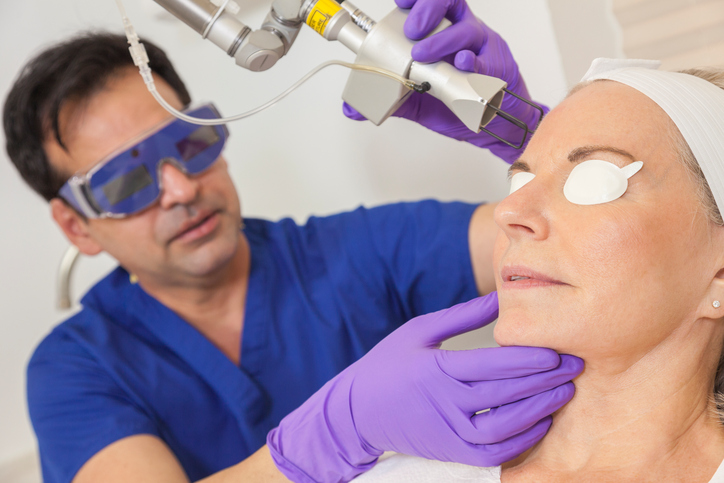Laser Resurfacing

Laser Resurfacing: Definition and Characteristics
What is Laser Resurfacing?
Laser resurfacing is a medical and cosmetic procedure that utilizes focused beams of light energy—usually through carbon dioxide (CO2) or erbium lasers—to remove the outer layers of the skin, stimulate collagen production, and promote regeneration of smoother, tighter new skin. This technique is commonly used to address signs of aging, uneven skin tone, scars, and sun damage on the face and other areas.
Characteristics
Mechanism
Laser resurfacing works by delivering intense, controlled pulses of laser energy to the skin’s surface. Ablative lasers remove the superficial layers and heat underlying tissues to promote collagen formation, while non-ablative lasers heat deeper skin layers without removing the surface, inducing mild tightening and collagen stimulation. Fractional lasers create microscopic columns of treated tissue for targeted results and shorter recovery times.
Symptoms and Uses
Laser resurfacing effectively treats:
- Fine to moderate wrinkles
- Acne, surgical, or chickenpox scars
- Uneven skin pigmentation and age spots
- Sun damage
- Skin laxity and textural irregularities
Clinical improvement is seen in skin tone, texture, and firmness. The procedure is primarily performed on facial skin but may be applied to the neck, chest, and hands.
Risk Factors
Potential risks include pain, redness, swelling, infection, prolonged changes in skin color, scarring, and delayed healing. Pre-existing skin conditions, extensive sun exposure, and prior herpes infection increase complication risks. Recovery varies with laser type: ablative procedures require weeks of healing, whereas non-ablative and fractional techniques have shorter downtime.
Clinical Significance
Laser resurfacing is an advanced method to rejuvenate skin quality and reduce visible signs of aging. It offers precise, customizable treatment with results lasting months to years. Careful patient selection, pre-procedure planning, and strict sun avoidance post-treatment are crucial for optimal safety and outcomes. Multiple sessions may be necessary to achieve desired effects.
Key Points
- Laser resurfacing uses ablative and/or non-ablative lasers to remove and rejuvenate skin layers.
- Treats wrinkles, scars, pigmentation flaws, and other skin irregularities.
- Risks include infection, delayed healing, pigment changes, and pain.
- Recovery and results depend on laser type, skin, and post-care.
Consult with Our Team of Experts Now!
For personalized evaluation, treatment options including Cellular Therapy and Stem Cells, and recovery management for laser resurfacing, consult our dermatology and cosmetic surgery specialists.
References:
- Hantash BM, et al. Current Laser Resurfacing Technologies: A Review that Delves into Fractional, Ablative, and Nonablative Techniques. J Clin Aesthet Dermatol. 2006 Jan;9(1):112-119. doi:10.1111/j.1524-4725.1999.tb00798.x. Available at: https://pmc.ncbi.nlm.nih.gov/articles/PMC3580982/
- Mohr A, et al. Assessment of Laser Effects on Skin Rejuvenation: Histological and Molecular Changes After Laser-Assisted Therapy. J Lasers Med Sci. 2020 Mar;11(1):14–21. doi:10.34172/jlms.2020.04. Available at: https://pmc.ncbi.nlm.nih.gov/articles/PMC7118506/
- Li Y, et al. Advancements in laser technologies for skin rejuvenation: A comprehensive review. J Cosmet Dermatol. 2024 Aug;23(8):2055-2068. doi:10.1111/jocd.16514. Available at: https://onlinelibrary.wiley.com/doi/10.1111/jocd.16514
- Preissig J, et al. Dynamic Panoramic Presentation of Skin Function after Fractional CO2 Laser Treatment. Dermatol Therapy. 2023 Sep;36(5):e1636. doi:10.1016/j.det.2023.09.001. Available at: https://www.sciencedirect.com/science/article/pii/S258900422301636X
- Alam M, et al. The Use of Lasers and Light Sources in Skin Rejuvenation. J Am Acad Dermatol. 2021 Mar;84(3):643-662. doi:10.1016/j.jaad.2021.01.011. Available at: https://www.sciencedirect.com/science/article/abs/pii/S0738081X19300756















